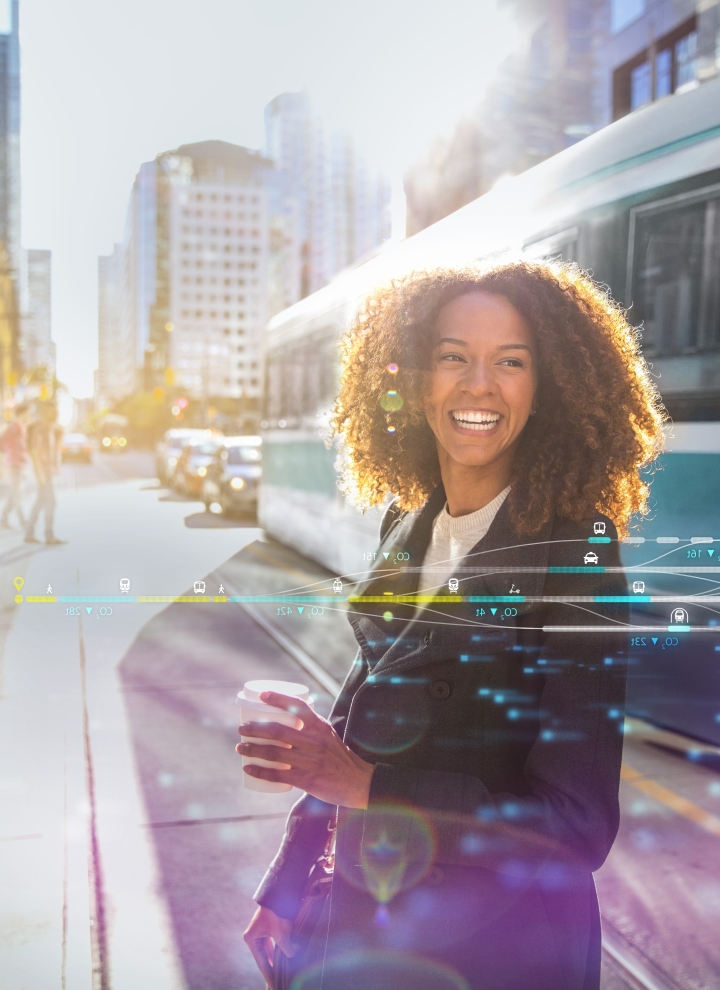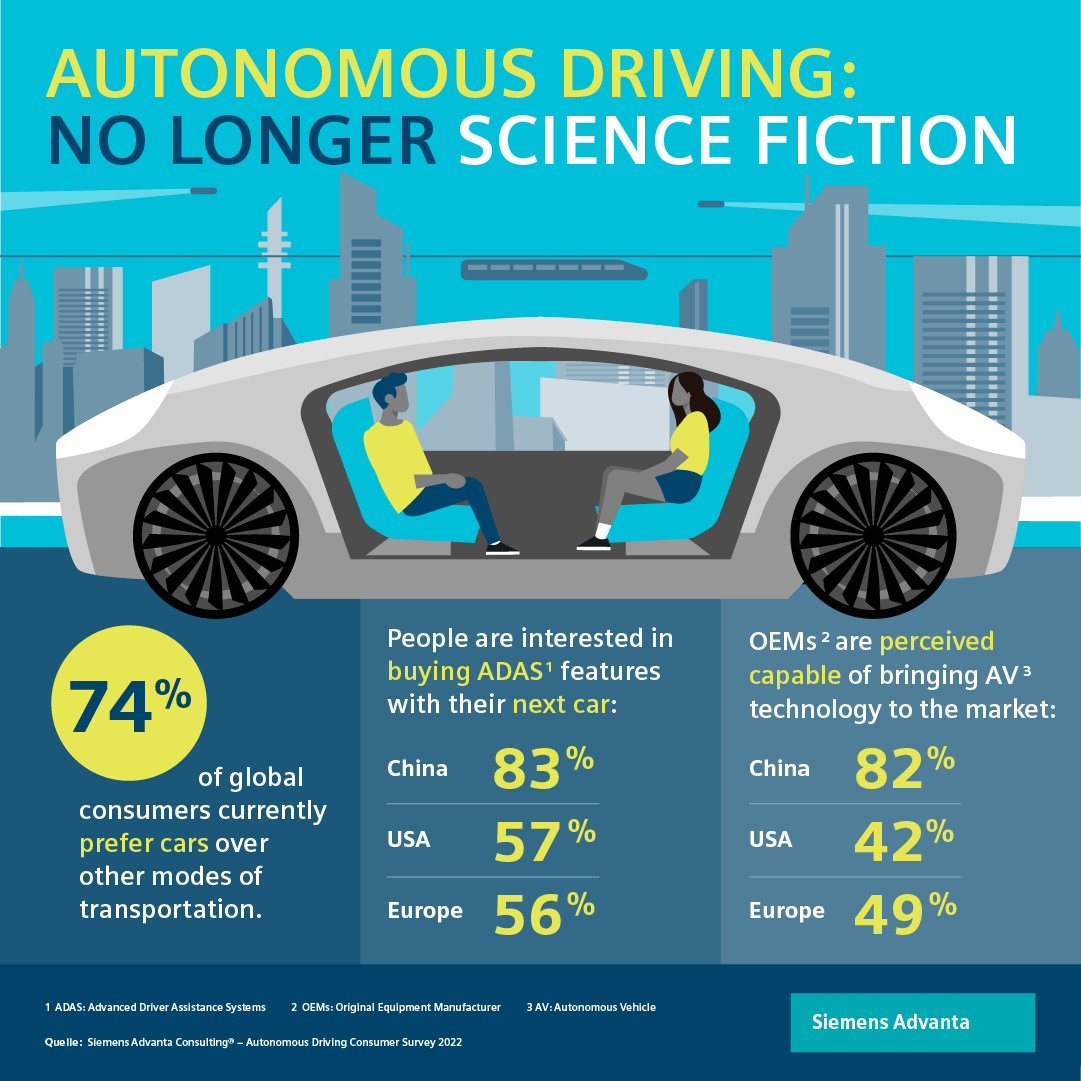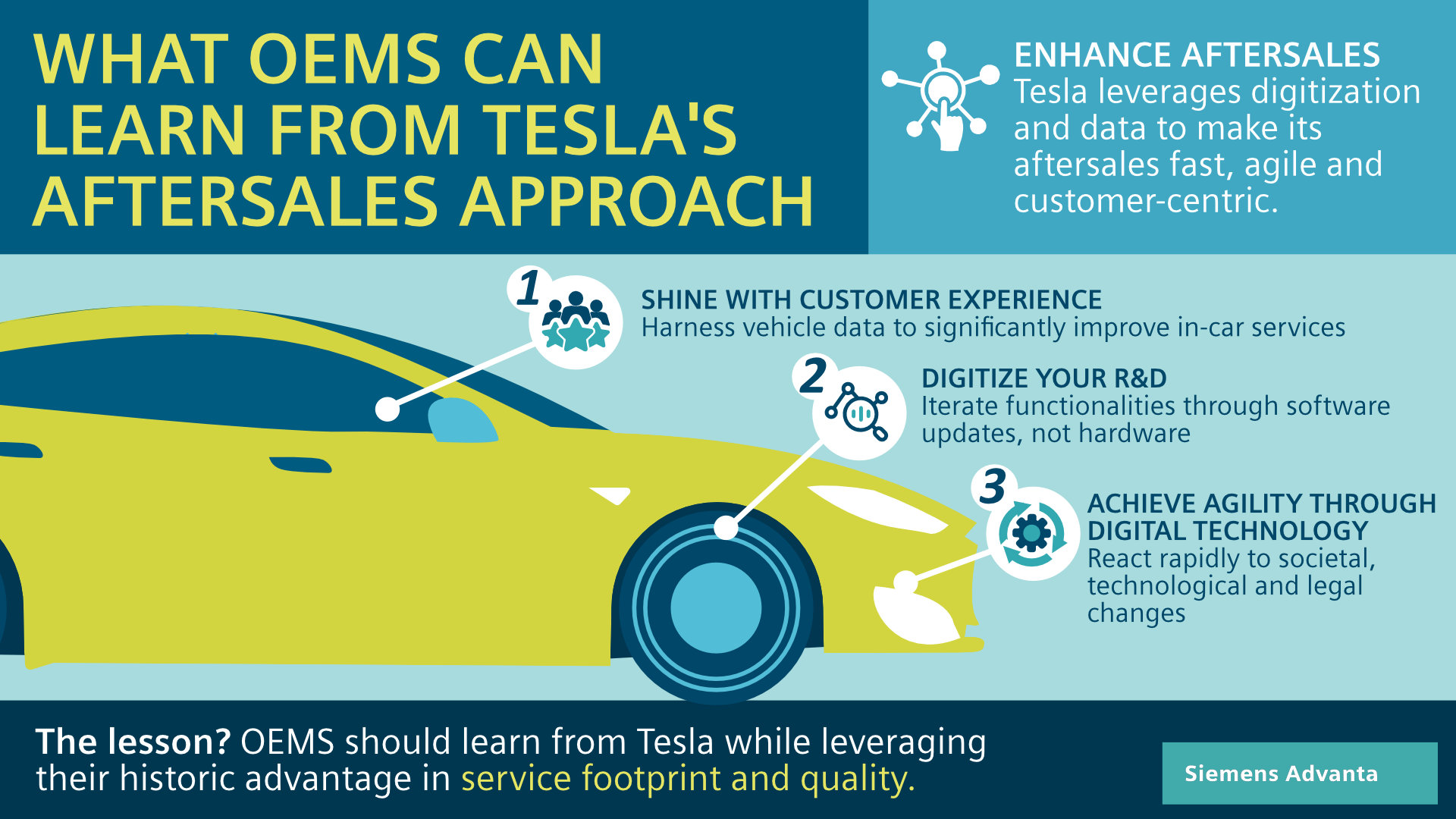An Easier Ride: Customer Expectations with Autonomous Driving

An Easier Ride? How to Meet Customer Expectations with Autonomous Driving Technology
What started as mere science fiction is now becoming a reality. Fully autonomous driving capabilities and even Robo-Taxis and Shuttles are already being introduced in some markets, complementing the more basic Advanced Driver Assistance Systems (ADAS). The future is here, now, and we can grasp it with our bare hands.
After a relatively long period of hype, the technology is now rapidly maturing and becoming increasingly prevalent. Many drivers already rely on ADAS features, such as automatic emergency braking and lane departure warning and correction systems. While this technology makes driving even more convenient for consumers, most automotive players are still uncertain about customers’ specific autonomous driving needs and concerns.
To market autonomous driving technologies effectively, automotive players need to understand a wide range of factors relating to questions such as: How are customer expectations evolving? What are the specific pain points, and how can they be effectively mitigated? How much do customers value autonomous driving features and what is their willingness to pay for different solutions? How relevant are established brands to market these solutions to customers and are there regional or other demographic differences?
To shed some light on these questions, we recently conducted the Autonomous Driving Consumer Survey 2022. We surveyed more than 2000 participants from three regions, namely the US, Europe, and China, through a representative online panel. Our findings reveal sentiments that may raise some eyebrows but will undoubtedly give valuable food for thought to all kinds of stakeholders involved in making autonomous driving a reality. This includes, for example, car manufacturers, technology companies, but also (local) authorities, and research institutions.
Cars and brands are still a subject of desire
Our results show that, without a doubt, people still love cars. 74% of consumers surveyed globally expressed a preference for cars over alternative modes of transport under current conditions. Even under ideal conditions (e.g., perfect availability and reliability, safety and cost, of alternative modes of transportation), the majority (59%) of respondents prefer cars. Cars will, therefore, likely stay relevant in the foreseeable future.
However, the role of currently leading car manufacturers in the future of mobility has often been questioned over recent years. Many have predicted that traditional OEMs will become increasingly irrelevant. Our results contradict this notion by showing that customers have high perceptions of traditional OEMs’ abilities to introduce AV technologies to the market. Chinese consumers are especially confident (82%), followed by Europeans (49%) and Americans (42%). Furthermore, most consumers have more confidence in traditional OEMs than in new tech companies in this regard.
On the contrary, new electric vehicle (EV) makers such as Tesla, divide regional opinions. In the US, consumers are more confident in these companies (60%) than in traditional OEMs (38%). Chinese consumers have comparatively more balanced perceptions, assigning 68% and 63%, respectively. European consumers, however, have similar faith in both new EV OEMs (52%) and traditional OEMs (52%). Contrary to common perception, these findings highlight the high relevance of both cars and traditional car manufacturers to consumers.
Driving automation needs an image boost
Chinese consumers are especially interested in ADAS, with 83% intending to purchase these features with their next car. Furthermore, 87% of them would go so far as to switch to a different car brand if that meant securing better ADAS implementation.
In Europe and the US, however, enthusiasm for ADAS is substantially lower. 56% of Europeans and 57% of Americans are interested in purchasing ADAS features, while 44% of Europeans and 49% of Americans would consider switching car brands in exchange for improved ADAS features. Still, the results highlight that ADAS features are a key differentiator for OEMs, even in these markets.
More importantly, manufacturers in Europe and the US need to establish why consumers are reticent. When asked about the reasons, the most common responses revolved around the arguments “unawareness of features” or “the system is too expensive.” These findings imply leeway for a better explanation of ADAS features and their benefits to consumers and/or finding alternative bundles or pricing models to address respective concerns.
Addressing such consumer concerns and reducing uncertainty should be a top priority for manufacturers before marketing the technology.
When asked about the reasons for their doubts, customer's most common responses revolved around the arguments “price of systems” or “unawareness of features”.
“How to pay” as a key question
There are essential factors to consider when trying to overcome obstacles for vehicle or feature purchases: pricing and payment models and differing preferences between consumer groups.
The attitudinal differences between China and the West are also evident in pricing and payment models. For connectivity services, 78% of Chinese consumers accept new payment models (e.g., pay-per-use or subscription-based), compared to just 42% of American and 34% of European consumers. However, even more striking is the difference in uncertainty in this regard, with 9% of Chinese, 29% of American, and 31% of European consumers who are not sure of whether to accept such payment models. The acceptance of new payment models for functions on demand diverges similarly (China 75%, US 36%, Europe 30%) and shows comparable rates of consumer uncertainty.
There are also important preference differences between consumer groups for other demographic variables, such as age. In the US and Europe, acceptance is lowest in the over-60s and highest in the under-30s. While this is not surprising, it’s the acceptance rates among the over-60s in China that are striking. A massive 65% of these older consumers accept new payment models, compared to only 22% of American and 15% of European over-60s. OEMs need to be aware of such demographic differences while ensuring that each payment model’s benefits are crystal clear to their consumers.
What OEMs must do to overcome these differences
What do OEMs need to take away from the messages consumers are conveying? For us, it nails down to three different imperatives.
1. Develop products that fit customers’ needs
OEMs must sharpen their focus on products that circle around customers’ needs. Developing autonomous driving features for the sole purpose of doing it won’t bring a competitive edge. Manufacturers need to realize how to make autonomous driving technologies as comfortable, easy to handle, and therefore as desirable as possible. Manufacturers should ensure their product strategies reflect consumer needs on, for example, smartphone integration and connectivity services, especially in China.
2. Develop clear pricing models that fit customers’ needs
As previously mentioned, customers’ wishes towards pricing models differ strongly, for example between regions and generations. Customer centricity and proximity are vital to addressing customer preferences and reducing uncertainty in this regard. OEMs and other automotive players should offer tailored pricing models to relevant customer sub-groups to maximize their chances of successfully positioning their solutions in the market.
3. Educate!
One of the key challenges identified in this survey is that consumers, especially in Western markets, are often somewhat reluctant to the new offerings and indifferent in their preferences. Therefore, automotive players need to advance their efforts to explain the benefits of the technology and the advantages of new payment models. This will be crucial to ensure high adoption rates and stable revenues early on. If people know “what is in it for them,” they will be more likely to press the purchase button.
Human behavior dictates highway ahead
Similar recently conducted surveys show that the ‘lack of consumer demand’ is not a barrier for autonomous driving technology adoption. Our findings support this notion. The demand is there, it just needs to be untapped. The process of getting there is simple: stay close to your customers and educate them as thoroughly as possible to tackle potential obstacles along the way.
With increased awareness, the potential to gain business value from autonomous driving is not something from a sci-fi movie anymore. It’s just around the corner.
Who knows? Maybe flying cars or time machines are next!
Download the survey
How do consumers perceive autonomous driving these days? Will the new technology influence their purchasing and mobility decisions? We recently conducted a survey asking more than 2000 participants globally this exact question. Find our key learnings here.
Our expert

Author


What OEMs Can Learn from Tesla’s Aftersales Approach

What OEMs Can Learn from Tesla’s Aftersales Approach – and What is the Company’s Achilles’ Heel
Listen to the blog here:
Tesla is a fairly new company compared to the larger and more established original equipment manufacturers (OEMs). While traditional OEMs have been around for decades, Tesla only released its first all-electric car as recently as 2008. However, to many, Tesla car technology often appeared to be one step ahead of the rest of the car manufacturing industry ever since.
Perhaps this is why we have seen Tesla stock prices soar. Investors seem to see Tesla more as a software company similar to Google or Apple rather than an automotive manufacturer and therefore value Tesla at a price-earnings ratio of 358 versus Volkswagen at 4.7 and BMW at 4.9. They tend to like forward-thinking companies with a strong vision of the future even if feasibility of that vision has yet to be demonstrated.
Tesla's success lies in the fact that it is perceived to be a leader when addressing CASE trends, namely connected, autonomous, shared and electric mobility. Its undoubted focus on data systems and the ability to leverage the full potential of digitalization is what makes the company a strong performer in today's market. Nevertheless, this focus on digital technology is just a part of the story.
Still, there have been multiple discussions in the automotive industry, as well as on Wall Street concerning the ability of Tesla to fully deliver on the promise it shows. To do so, Tesla must not only grow its fleet to maintain market share in a booming market for electric vehicles, but also further improve its profitability: Margins on new vehicle sales are often limited due to heavy price competition and the inability to reduce material cost.
Accordingly, it might be worthwhile to shift focus to aftersales as the future driver of profits. However, despite its superior position and high expectations, Tesla does not (yet) generate any profits with its aftersales business. While the 'average' OEM heavily relies on aftersales for their overall profits, Tesla still shows a deficit in their annual report.
This prompted us to take a closer look at Tesla’s approach on aftersales to better understand strengths and weaknesses.
Success factors of Tesla’s automotive aftersales process
We identified five different aspects that are essential for Tesla's aftersales setup.
Improving customer experience over the air
Leveraging the so called 'closed data loop' throughout its digital systems, Tesla is able to improve its product offering to the consumer even while it is in their possession. It can do this in almost the same way that Apple, for example, by issuing an upgrade or software update to the customer without the hardware needing to be brought into a service center. From the start, Tesla has focused on collecting data and using it for enhanced decision-making to continuously improve its products. This closed data loop has led to an irrefutable perception of sustained value and reputation among consumers. There is an associated risk with this success factor, however, which should not be overlooked: Since more data is collected and more functions can be manipulated over the air, the data security risks increase, as well. Furthermore, as vehicles sustain their perceived value for longer, future new car sales may be in danger since older but upgraded vehicles are still cutting edge.
Enabling hardware iterations
One major advantage is Tesla's ability to rapidly iterate its hardware. Being relatively close to the customer means that the firm can be very responsive when dealing with customer feedback and demands. Nonetheless, more product variance means increased cost of complexity. This could become a liability in the longer term, if it is not managed very carefully: Each introduced variant must be serviced and maintained throughout the product lifecycle. Establishing a strong Product Lifecycle Management will be essential for OEMs of the future if they want to control complexity costs while rapidly adjusting to customer desire. It can even be beneficial to design the vehicle in a way to avoid hardware changes. This can be achieved by realizing functions via software rather than hardware and by slightly “overequipping” the car. This approach would then later use the additional computation power, bandwidth or sensors / actuators to implement additional functions via the closed data loop.
Adapting to legislative constraints
Tesla chose a high-risk, high-reward strategy with respect to the various legislative and regulatory constraints it faces in different markets. This strategy allows the company to make very quick progress with nascent technologies, such as autonomous driving systems. Assessing the risks of potential legislation in areas like autonomous driving and data privacy has been cornerstone to Tesla's success so far. However, it necessarily exposes Tesla to significant liability risks. In many cases Tesla will set the standard by being the first. But what happens if legislation demands a different approach later on? As an example, Tesla currently faces minimal legislative coverage in the way it locks in customers to its systems and services. As the discussion around the “right to repair” demonstrated vividly, future legislation in markets, such as the EU, could open up competition and undermine the “closed ecosystem” strategy. If Tesla continues in this potentially risky manner but plans sufficient mitigation for future legislation, then it should be able to enjoy continued success.
Embracing a start-up mentality
Despite the rapid growth it has experienced, Tesla has successfully managed to maintain its “start-up mentality” in its governance setup. Unlike most major car makers, the company does not have a highly complicated governance operation. Indeed, Tesla is still running numerous strategic decisions through the firm's headquarters. This means the company can operate in an extremely agile way. However, with increasing sales volumes abroad and the potential for different legal restrictions, the central approach might complicate satisfying local customer demands. Also, as more and more spare parts are needed, establishing a local supply chain is becoming increasingly practical. Consequently, it might become even more attractive for Tesla to shift away from the centralized approach – while OEMs on the other side need to become more agile.
Tesla has successfully managed to maintain its “start-up mentality” in its governance setup.
Service footprint and quality as Tesla’s Achilles' heel
In our analysis it became obvious that the company's service footprint and quality is not such a clear-cut case and might even be Tesla’s Achilles’ heel. Tesla is working to establish a lean service network and can provide mobile solutions to its customers. However, success in this field is limited: still, Tesla’s aftersales support needs significant improvement. Customers, for instance, criticize having to wait very long for appointments, low availability of spare parts, difficulties to reach customer service as well as low quality of the work provided. A 2019 study of Bloomberg showed that roughly 20% of customers claimed to be dissatisfied with timelines of service and adequacy of repairs. Interestingly, between Q4 2019 and Q4 2020, Tesla grew vehicle deliveries by 60% (from 112k to 180k) while store and service locations grew by 20% only.
The underlying problem seems to be a structural one: Tesla’s fleet has been growing at a pace which the aftersales network simply couldn’t keep up with. Spare parts are scarce due to most resources being used for vehicle production. The prioritization of new vehicles sales was right to grow the fleet and capture a significant market share. Now, as the BEV market booms, Tesla must continuously increase output to at least retain their current position. At the same time, it is imperative to build a strong aftersales network and significantly improve customer experience. This requires strong investments which of course will have a corresponding impact on Tesla’s balance sheet. However, the cost of failing to invest in the aftersales network might not be financial only. It could put the firm's closed ecosystem approach at risk as they would have to rely more on third-party partners to handle service requests. Dissatisfaction could ultimately also impact new vehicle sales.
Overall, Tesla is leading the pack in four out of the five dimensions we investigated. Tesla's Achilles' heel turns out to be the service footprint and quality. OEMs seeking to optimize their aftersales setup will want to learn from Tesla's best practices while playing to the strengths and quality of their existing service networks. Development potentials lie in closing the gap between them and Tesla for software and hardware product improvements, agile mentality and fast legislative adaption. At the same time, they should leverage their advantage in the service footprint and quality to provide superior customer experience. So, what should OEMs focus on immediately?
What can OEMs learn from the Tesla example?
The main thing that OEMs can take from the case of Tesla is that they ought to leverage digitalization even more than they currently do. Tesla clearly shows several best practices and market-leading processes with respect to customer-centric operations. Because of its world-class data-driven business systems, its operational model is able to provide rapidity of action in the marketplace that few others could even hope to match. This means that OEMs can learn from Tesla's best practices regarding digitalization in three distinct ways:
Shine with customer experience
It is not just in the automotive sector that customer experiences are now closely entwined with their digital experiences. However, in car manufacturing, there is a specific way that OEMs can harness data to improve their customers' experiences. This would include leveraging data drawn from vehicles in the field to continuously seek new ways to improve software and in-car services. Doing so opens the door to the creation of new or additional revenue streams. Will customers pay for software upgrades and new digital services? The likelihood is they will, especially if the customer experience is demonstrably improved by such offerings. What's more, OEMs can benefit from direct-to-customer sales with this model and not rely on dealerships or other third parties.
Digitizing research and development
Secondly, OEMs should learn that the feedback data they obtain from the fleet that is on the road is invaluable to their future R&D processes. With data flowing in almost constantly, analyzing it well will mean being able to quickly iterate product features that have the highest customer relevance or demand. OEMs must make this data easily accessible to product designers to enable well-founded decisions. Furthermore, R&D teams should shift to implementing new functionalities in software updates – rather than with hardware – to allow greater speed with the rollout of new features, such as autonomous driving systems, for example.
Utilize digital technology to revise risky behavior
Finally, OEMs should learn from Tesla's corporate governance model and set up a more agile organization, one that is more able to react rapidly to technological change. Digitalization means embracing a fast-moving world in which risk-taking behaviors can be beneficial as long as they're based on solid data. Unforeseen developments in society, technology, and legislation need a governance structure that is prepared for them, and only big data analysis can help to inform the future size and shape of any commercial operator in the automotive sector. For most OEMs that will mean to tear down the silos that have established over time. With the fundamental shift we see in automotive, fundamental innovation is required: Salespeople must work with R&D and product management to find a solution for one global problem instead of focusing on many smaller local topics.
Why automotive aftersales service remains crucial in the digital world
In summary, Tesla is a shining example of how OEMs can challenge the status quo. At the same time, the weakness in aftersales service footprint and quality as their potential Achilles heel demonstrates the value of grown structures and established networks. Although Tesla’s growth is breathtaking, there are limitations on how quickly they can build a strong aftersales presence.
The strength of traditional OEMs has been with their existing production and sales volume. This has allowed them more room for strategic action in building a sustainable and profitable aftersales network. OEMs should seek to exploit this natural advantage to convince clients with superior service as they introduce more and more BEV vehicles. At the same time, they should follow Tesla’s example and leverage their current aftersales networks to help them unlock the potentials of digital transformation and significantly improve their aftersales by digital means.
Free whitepaper
Read our whitepaper to learn how to develop comprehensive data strategies to identify new business opportunities and prepare your company for the digital age!
Our expert

Author


What Rugby Taught Me About Growth Mindset

What Rugby Taught Me About Growth Mindset
Listen to the blog here:
When I was 14, I was thrilled to take on rugby. Despite being small for my age and not particularly strong, I enjoyed the team game and discovered that the physical and mental challenges of it allowed me to push myself in new ways. Due to my physique, it would have been no surprise if my playing experiences had gone wrong, but two years into it, my team and I were participating in both national and international competitions. I wasn’t the fastest or the strongest kid on the field, but I could use my agility to contribute to the team’s success. I almost always got tackled and believe me when I say that my parents were convinced my bruises would never fade. I will never forget what my trainer once said to me around this time: “We have guys who are faster, bigger and stronger than you. Do you know why I am taking you in for the competitions and not someone else? You are a team player. You think for the entire team!” I felt deeply honored. I was very much aware of my limitations, but that sentence has shaped me forever.
Later, as an adult, I realized that rugby taught me so much more than just being a team player. Remembering certain situations on the rugby pitch, I realized that I chose to act with different mindsets. Sometimes I had the tendency to limit myself, and my fixed mindset was holding me back, but often I had the desire to learn and could act on – what I know now – a so called growth mindset.
I had experienced what it took to have a growth mindset on the rugby pitch, but later in life, I found that it could be equally applied to the business world. Nowadays, we all know that in a business sense, the world is constantly changing – just like the shifting play on a rugby field. Therefore, companies need to adapt to meet the needs of their customers and markets. Consequently, organizations must stay curious, resilient, willing to experiment and adapt. Basically, if they don't nurture a growth mindset, they are much more likely to fail.
Looking back on my rugby career, I now see a connection between what I was doing then and what I do now professionally. When I was on the pitch, it was not just about teamwork and self-confidence as a player but something else that led to success. It was the mindset.
A growth mindset definition for business and sports
Academics have sought to define a growth mindset, take it from Carol Dweck, a professor of Psychology at Stanford University. According to her, a growth mindset is based on the belief that anyone's underlying qualities are things they can cultivate through their efforts. “Although people may differ in every which way – in their initial talents and aptitudes, interests, or temperaments – everyone can change and grow through application and experience,” she wrote. As mentioned by Dweck, there are two main mindsets with which we can navigate our way through life: growth and fixed. Both mindsets face challenges, obstacles, effort, criticisms, and responses to the success of others. However, they deal with them in very different ways. People with a growth mindset, for example, embrace challenges and see effort as a pathway to mastery. In contrary, people with fixed mindsets will avoid challenges, give up when they encounter obstacles and feel threatened when those around them enjoy success.
That connects with my business experience today as well. The adoption of a growth mindset is important to me because there is nothing more fulfilling than seeing how people around me are developing on their journey and are helping others develop. I believe that the biggest barrier for change in oneself is very often one’s own mind.
This is something emphasized by my colleague Bettina Rotermund, Head of Strategic Marketing at Siemens IoT: “We constantly need to try out new things in order to succeed and to be ahead of the curve. If you try out new things, then the chance of failing in the first place is quite high, but we need to push ourselves out of our comfort zone and try something out.”
Growth mindset vs. a fixed mindset on the rugby field
According to Carol Dweck’s definition, both mindsets face the same characteristics. It’s about how people deal with challenges, obstacles, effort, and criticism. Let’s have a closer look at these four areas to better understand the differences between both concepts.
Challenges
When I began playing rugby, I was smaller than the others on my team. I didn't have their experience or power. However, I was open to what the coaches told me and to finding ways where my physicality wouldn't hold me back. In fact, I used my agility rather than brute strength to help my team gain momentum. In short, I had a growth mindset that embraced the challenge of a physically demanding game where brainpower often counts just as much as brawn.
Had I had a fixed mindset, what would have happened? Most likely, I would have never discovered I could manage on my own towards the ends of games as some of the bigger players tired. I would not have found that my team player status was so valued among my teammates, and I wouldn't have gone on to enjoy so many memorable wins with them either.
Obstacles
As Dweck points out, how you handle obstacles is a key part of differentiating a growth mindset vs a fixed mindset. Overcoming obstacles, as opposed to avoiding them, is key to demonstrating a growth mindset. One of the growth mindset characteristics I found I developed as a rugby player was derived from the fact that I was often too aware of my limitations as a player. An obstacle I faced on the pitch every time I played was tackling a bigger player coming my way. However, by learning the right technique and using his body weight against him in contact, I was able to learn how to overcome this obstacle.
With a fixed mindset, I'd have failed. I could have opted for what I knew was comfortable and put in a poor attempt at a tackle, of course. However, that would have meant another player on my team having to take responsibility on my behalf and double up the defense. That's the consequence of a fixed mindset that sees obstacles as insurmountable. It's something I hear in business: that things cannot be done. However, with a growth mindset, there is no obstacle that cannot be overcome.
Effort
In rugby, work rate, or distance covered by a player during a match, counts for a lot. Teams that have more tackles tend to win, especially in close games. The try scorers and kickers may get the plaudits, but the team effort is what counts. Anyone who has played the game rather than just watched it knows that. As the American Football Coach, Vince Lombardi, once said, “Individual commitment to a group effort is what makes a team work.” Lombardi went on further, saying it is also what makes companies and even entire civilizations work.
Looking back, it now seems obvious to me that this was a behavior of a growth mindset. I'm glad I put the effort in because, without it, I'd have not seen the benefit of a team working together and, perhaps, played for individual glory. Rather like the Gestalt theory of mind, we need to see the big picture rather than micro-managing our own efforts. In short, we're greater than the sum of our parts, but with a fixed mindset, you may never realize this truth.
It's something I hear in business: that things cannot be done. However, with a growth mindset, there is no obstacle that cannot be overcome.
Criticism
As a rugby player, our coach had some open and honest conversations with my teammates and I about what we were doing wrong collectively and what we needed to change tactically. As a kid you don’t like to hear about what you are doing wrong, that’s for sure. Of course, I tried to use the feedback that my coach gave me, but was I feeling good about it? Not really, and sometimes I couldn't take the criticisms that came my way, which affected my game. A classic example of a fixed mindset.
Had I had a growth mindset back then, I would have been able to deal with constructive criticism. I would have been open to it and even have encouraged it. That being said, the experience shaped me. I now see that players with growth mindsets don't take such critical conversations personally, and this is a quality common to most highly successful athletes, not limited to rugby.
I realize now that a fixed mindset affects us all to some degree. Staying in your comfort zone often means thinking you know what’s best for you, which you might! However, without a growth mindset, you will never know for sure what else you could have learned from a fair and valid critique of your work.
The Success of Others
Let's face it, winning is great. Playing in front of your family, friends and teammates as a kid and then winning is one of the greatest feelings of happiness and motivation. Losing on the other hand, that hurts. When I was a kid, I couldn't bear losing, and I could think of enough reasons why the other team didn't deserve to win or why it was just a close call that made them win. Now I know that this is a prime example of a fixed mindset, and I was not able to acknowledge the success of others because of my jealousy and my inability to draw anything positive from it.
Instead, playing in a team with a growth mindset, I should have been able to enjoy the success of those around me. Through failure we should support each other, both other teams and other teammates, and acknowledge the sacrifices others make to get to where they are today.
This is just as true playing team sports as it is working for a forward-thinking organization like Siemens Advanta. Corporate culture means adopting a growth mindset, and this helps everyone to enjoy each other's successes and savor the contributions we, as individuals, have made.
At Siemens Advanta, we have a mindset to be proud of. Of course, not everyone and especially not every individual has a mindset that is 100% and always that of a growth mindset, but our company’s focus currently is to encourage each employee to work on himself and herself and to develop constantly. Without it, the organization would not be the versatile innovator it is. Furthermore, with a fixed mindset, the various teams wouldn't enjoy each other's success to the same degree. That would be detrimental for the entire ecosystem of professional cooperation and, in the end, the commercial resilience of the company. Enjoying the success of others isn't just about a pat on the back, but also ensures organizations can change and adapt to meet all future challenges.
Growth mindset learning in summary
In sports, being able to embrace challenges, overcome obstacles, put in the effort that is required, take criticism and use it as positive feedback, and take delight in the success of others yields results. Especially in team sports, having each of these growth mindset characteristics means being able to get more out of the activity than previously expected.
Sure, a growth mindset in a team game can bring about more success on the field, but it goes further. Look at my story: Through rugby and other valuable life experiences, I have learned and have developed a growth mindset – but how do I apply that mindset today? The answer is I try to apply it to everything I do professionally. I've taken that growth mindset and continued to use it throughout my career, encouraging others to do so and step out of their comfort zones along the way.
Through my personal story and the deep dive of the individual five characteristics of the two types of mindsets – growth and fixed - it should become clear what significance a growth mindset can have for success in life, in work and, ultimately, for a company. For me, being eager to learn about curiosity in personal development is something that I am constantly learning over and over again. Especially as a leader, it’s so important to help others develop, help them to be open and curious, and to acquire new skills to constantly nurture their growth mindset.
By investing in partnerships and ecosystems as Siemens does, it is possible to develop a growth mindset that will lead to prolonged business success. As my colleague Bettina puts it, “Our markets and our environments are changing so rapidly and our innovation circle has become so short, we constantly need to try out new things in order to succeed and in order to be ahead of the curve.”
Especially as a leader, it’s so important to help others develop, help them to be open and curious, and to acquire new skills to constantly nurture their growth mindset.
Changing your mindset with growth mindset goal setting
If you dare to dream, then you can step out of your comfort zone as well. I know many people will have fixed mindsets, and it is also important to accept this. No one should be unnecessarily critical of a fixed mindset if there is the willingness to change. For some, it may come easier to switch to a growth mindset than others; change is a process, not an end result! Set achievable growth mindset goals for yourself that allow you to step out of your comfort zone and to experiment with new ways of doing things. After all, experimentation is part of what it takes to obtain a growth mindset and shift away from a fixed one.
Remember that it doesn’t happen overnight, nor can one completely maintain one type of mindset only. We're all a blend of the two to some extent. As rugby players know, sometimes you need to tighten up your game while in other situations, you need to take more risks to overcome the opposition.
Our expert

Author


How Will Technologies Shape a Bright Digital Future?

Society 5.0: How will Technologies Shape a Bright Digital Future?
Listen to the blog here:
Dr. Oliver Elbracht (Siemens Advanta): The Society 5.0 concept emerged from the Information Society and was initially expounded in 2016 in the Far East. In Japan, the new societal model was first defined to mean a human-centered approach to the ever-growing take-up of technology. Also called ‘super-smart society’, it aims to balance economic advancement more widely across society, for example, as well as create an opportunity to think about how certain social challenges can be resolved by digital technologies such as big data, Artificial Intelligence (AI), the Internet of Things (IoT) and robotics.
Having a closer look at the Middle East region, digital transformation programs are already in full swing: from oil fields, to manufacturing, to city infrastructure. Leaders in the region are aware of the societal and business demands and are already addressing the emerging challenges to shape the transition into the future.
I’m Oliver Elbracht, Managing Director for Siemens Advanta in the Middle East, and in the context of the event Transformena 2021 in April this year, I had the honor to sit down with several remarkable leaders from corporations in the Middle East to discuss how technology is creating a better tomorrow. Below you can find an extract from my discussion with Neetan Chopra, the CTO of Dubai Holding, Ahmad Aalem, the former Head of Strategy at The Red Sea Development Company, and Abdullah Albalushi, who holds the role of Board Advisor at The Zubair Corporation LLC in Oman.
The answers of these great panelists were certainly quite revealing, as I'm sure you'll agree with this insightful discussion.
Dr. Oliver Elbracht (Siemens Advanta): Ahmad, is focusing solely on technological solutions and their implementation enough to achieve the Society 5.0 concept?
Ahmad Aalem (The Red Sea Development Company): The Red Sea Development project is focused on creating a luxury tourism destination, that is based on the sustainable concept of regenerative tourism through a twin approach of person-centered and technological change. We are no longer settling for simply protecting and preserving the environment. We aim to enhance it. Indeed, we are committed to enhancing Saudi Arabia's natural ecosystem by 30 percent over the next 20 years. Crucially, it is technology that will enable this link between tourism, the environment and sustainability. Construction in sensitive areas may mean a modular construction method with manufacturing on-site, which needs to be sustainable, but this means you need people on board with the entire concept, not just the technology itself.
Dr. Oliver Elbracht (Siemens Advanta): How can technologies benefit people within the concept of Society 5.0?
Ahmad Aalem (The Red Sea Development Company): A good example would be our adoption of a smart destination platform, that allows guests and workers to monitor the environmental conservation enhancement across our lagoons – up to 2,400 square km of water. One of the best examples of the 52 smart technologies we've adopted is a wearable device for employees and vehicles to help maintain the balance between the environment and efficient construction. This device enhances employee welfare, too, by making sure they are supported by improved security measures, for example, by allowing an SOS signal to be sent. For now, AI and smart tech deployment is focused on our employees as we're in the construction phase, but in the future, it will center on a seamless visitor experience.
Dr. Oliver Elbracht (Siemens Advanta): The progress you're making building this unique destination truly amazes me. Now, from a smart tourist destination in Saudia Arabia to a smart city in the UAE. How does smart technology contribute to Dubai's objective to be the smartest and happiest city in the world?
Neetan Chopra (Dubai Holding): From Dubai Holding's perspective, there are two main actions. Firstly, we want to be in the arena, not on the sidelines, getting stuff done. We take action in transformation, innovation, and technology. Secondly, we support the technological ecosystem, which is enabling innovation and transformation. Further, when it comes to digitalization, you need to create magical, memorable experiences for customers – and employees alike. That is critical for the whole transformation journey. You can't be digital in the front-facing part of your business but at the same time keep your back office analogue. That doesn't give you true transformation. Additionally, we've found that investing in new business models as well as forging symbiotic relationships between start-ups and enterprises is crucial.
Dr. Oliver Elbracht (Siemens Advanta): How are businesses using digitization to manage large numbers of employees across various industries?
Neetan Chopra (Dubai Holding): Forward-looking organizations recognize that you can't do digital or transformational change without including your employees. It's critical! If you only focus on the customer receiving great digital experiences but forget about your employees that’s not a true digital transformation. The digital platform we have adopted at Dubai Holding connects all 20,000 employees. This offers them the same level of digital experience as our customers expect.
Dr. Oliver Elbracht (Siemens Advanta): The scope, scale, and economic impact of technology have been rapidly expanding in the Middle East. How have forward-thinking corporations integrated technologies in the region?
Abdullah Albalushi (The Zubair Corporation): The Zubair Corporation is one of the longest established business conglomerates in Oman. It started its business back in 1969. Of course, the business landscape at that time demanded a very different way of doing things. Then, focusing on building the infrastructure of the country in cooperation with the government was the priority. Only a few corporations were able to meet this challenge. Those which, like The Zubair Corporation, were widely perceived to be part of government and, consequently, to have a lot of social responsibility. The government's 2040 vision expects Omani corporations to continue to meet these social demands in the country, so it will shape our future as well as our past.
Dr. Oliver Elbracht (Siemens Advanta): What is your approach to future digitization as Society 5.0 becomes an increasingly felt reality?
Abdullah Albalushi (The Zubair Corporation): We inherited various complex legacy systems, often by acquiring and merging with other companies. Therefore, after 50 years of business a check was needed to re-energize the company. We found that there was a big gap with what the younger generation expects, especially with mobile and digital technology. Given that we had historically dealt directly with the government, we didn't always need any of these technologies. Due to the Covid-19 pandemic, everything moved to digital, causing business and social challenges for us. In 2019, we conducted an operational review. Based on that, we developed a digital transformation strategy. We entrusted Siemens Advanta to be our partner in the assessment of our digital strategy, and we are now 50 percent on the way down the road to delivering it. As others have said, the human element in this is creating the biggest challenges, but it also affords us the biggest opportunities. We want to create a truly human-centered ecosystem where all our business units will operate on a single platform, the foundation to innovate and shine.
Dr. Oliver Elbracht (Siemens Advanta): It has been an exciting journey you have been on – not only within Zubair but really for the Omani nation.
I'd love to continue this to experience how you and all of your corporations are making a difference to Middle East societies within the contexts of Society 5.0. I'm excited to see how the Middle East will continue to develop this human-centered, technology-based society in the years and decades to come. It’s fascinating what the upcoming decades will bring and I'm convinced that we can foster innovation that will create a bright future for us and for future generations.
Thank you very much all of you for joining this discussion.
Interested in watching the full dialog? Click here to watch the recording of the panel discussion: Society 5.0 – The Big Social Transformation.
Free whitepaper
The Oil & Gas industry across the globe is facing a number of macro challenges. Several companies are banking on digital transformation in upstream to reduce the operating cost of fields making it viable to operate existing fields beyond their expected lifetime and explore small fields that were till now considered unviable. Download our whitepaper to learn more about tailwinds in upstream digitalization and how to leverage its full potentials.
Our expert

Author


What we can Learn from China’s Economy Restart

No Winter Lasts Forever – What we Can Learn from China’s Economy Restart
Listen to the blog here:
Traffic is moving and clocking-in machines are beeping again – life in China is resuming.
China’s economic recovery picks up speed at the end of 2020 – something many other countries are longing for. And it has done so more quickly than most observers expected. According to data from the National Bureau of Statistics, China’s GDP grew by 6.5% in the fourth quarter, being the only major economy to have expanded in 2020. This puts China a step ahead of the rest of the world on the recovery curve.
For me, developments in China provide valuable insights that can help us better understand and prepare for our recovery in Europe and the US. Which is why I am delighted that my colleague Xiaoxun (BJ) Zhu, Head of Siemens Advanta China, has taken the time to share with me his first hand experiences of recent months.
1. COVID-19: Learnings for western countries
Bettina: BJ, looking back over recent months, what, in your eyes, can countries in the West who are still in the midst of shutdown, learn from your experience in China?
BJ: China recognized the importance of digitalization in the fight against COVID-19 and exploited its potential. Many companies reacted quickly and developed customized digital solutions as a response to the new challenges. And when it came to ramping up the economy, it quickly became clear that a digital monitoring system was the only way to ensure compliance with the strict statutory regulations. Digital tools not only guard against a new wave of infection, they have also driven forward digital transformation in companies. That makes companies more future-proof and more resilient, as demonstrated by a report from the China Academy of Information and Communications Technology (CAICT) which examined the impact of the pandemic on companies in the IoT space.
2. Monitoring systems
Bettina: In Germany too, we are looking at ways of using digital technologies to better protect employees on company premises, like with Siemens’ Comfy App. What does your monitoring system look like?
BJ: Our system is a campus management system that we developed ourselves. It has a wide range of features, including access authentication, body temperature measurement, temperature status recording, preventive health advice, plus higher-value insights based on data analytics. It is an important element in our safety concept and has proved to be an efficient preventive tool. Our many years of experience in campus management meant that we were able to develop the tool very quickly. As a result, we were able to provide our clients in China with a cost-effective, efficient solution right when they needed it, as they got their operations up and running again.
3. Evolving situation
Bettina: It is impressive that you managed to develop and scale the system in such a short timeframe! I’m very interested to see whether similar concepts will be adopted in Germany too. After lockdown, many companies are struggling with cash flow issues and are fearful for the future. Where you are, the economy has started up again. How has the situation evolved?
BJ: Small and medium-sized enterprises, in particular, are still experiencing problems with their cash flow, unfortunately - and that includes some of our customers. To help them, we have developed a four-point action plan:
- Comprehensive analysis of the company’s financial position to identify losses and financing gaps
- Compile a multi-point budget plan with different scenarios and versions
- Conduct emergency budget planning to implement continuous monitoring of annual targets
- Optimize and align all enterprise management tools with the aid of digital technologies
Our experience shows that these steps are essential if a company is to be able to assess the impact of the pandemic on its own business. They form the basis for developing effective targeted measures to secure the survival of the company.
4. How to prepare for the future?
Bettina: I think that the cash flow problems are just the tip of the iceberg. In the current situation, what, as you see it, is particularly important for companies if they are to be equipped for the future?
BJ: With the many internal challenges facing companies at the moment, it is important not to lose sight of one’s own supply chain. Fast, efficient assessment of procurement risks and of the sustainability of the supply chain is absolutely essential. Those who have not yet done so, should first and foremost implement a crisis management system, centralize scheduling and expand their procurement channels. The next step, based on experience gained and using short-term success metrics, is to increase security of supply and improve the quality and efficiency of the supply chain. In the long term, the focus must be on optimizing the supply chain network and on end-to-end digitalization of supply chain management.
5. Will globalization continue?
Bettina: For me, that last point in particular has become more significant in the current situation. Globalization has meant that supply chains have become incredibly complex in recent decades. Daimler, for example, works with more than 213 tier 1 suppliers worldwide according to LBBW Research and Bloomberg. The 10 largest of these alone have 588 suppliers, and these in turn depend on 2,900 other suppliers. Keeping track of these is virtually impossible without the right tools. Do you agree, that the trend towards Glocalization will continue?
BJ: I think so, yes – you need to ensure that your supply chain is resilient and for this a dedicated risk management in balancing global AND local vendors definitively can help.
6. What is next?
Bettina: COVID-19 still has the whole world in its grip in the second and also third wave. Where do we go from here?
BJ: As the author Hal Borland put it so well - No winter lasts forever, no spring skips its turn. The pandemic is a turning point in the digitalization of the economy and society. If we are to be prepared for the upcoming uncertainties and the complexity of a digital, global economy, then a smart approach to the digital dynamic or as Christian Schuldt from the Future Institute aptly describes it - a digital resilience - will be critical to our success. Siemens, with its experience and insights, can make a valuable contribution to driving further developments in this area. In so doing, we make companies more flexible, more agile and, as a result, more competitive in the long term.
Bettina: Transformation of corporate culture also has a key role to play in building digital resilience. Digitalization must not be just a buzzword in organizations, it must be embraced actively by all employees.
Thank you very much BJ for these fascinating insights. I am certain that the four-point plan to address cash flow issues and the supply chain measures you described will be very useful for other companies too, as a way of mitigating the impact of the crisis.
Free whitepaper
Read our whitepaper to get a deeper, more practical understanding of how digital transformation can be a success story with the help of Integrated Change Management.
Our expert

Author


Business Trends and Action Fields in the Post-Covid-19 Era

8 Long-Term Business Trends & Action Fields in the Post-Covid-19 Era
Listen to the blog here:
The effects of the coronavirus pandemic have significantly affected everyone across the globe. The economic downturn experienced by businesses has decisively impacted various industries, such as travel, oil and gas and automotive. Rethinking business models to keep up with the changing economic situation is the new normal. But which long-term trends has the pandemic initiated in our society? What do businesses have to keep an eye on? And which actions can they take to remain relevant during and after the pandemic?
1. Digitalization
Supply chain disruptions, reduced physical interactions and international travel restrictions are some of the challenges which we are experiencing today. Companiesmust look for ways to mitigate the risk. Digitalization offers several opportunities as it will accelerate and further gain traction. Digital transformation aims at combining talent and technology to boost operational efficiency, customer experience and ultimately competitiveness in the market. A business needs to focus on all aspects of its value chain to achieve this:
-
Strategy
Adapt and define new business models leveraging e.g. the Internet of Things (IoT) or Artificial Intelligence (AI). -
Innovation and R&D
Speed up innovation cycles in Research & Development (R&D) and Product Lifecycle Management (PLM) by incorporating, for example, agile approaches or DevOps.
-
Supply Chain & Manufacturing
Focus on process automation, remote operations and flexible production(based on e.g. additive manufacturing). -
Organization
Manage increased complexity with the help of digitalization, optimize system architectures and drive modularization. -
Sales & Marketing
Improve customer experience through e-commerce and multichannel selling.
Companies need to consider the opportunities that digitization offers in various sectors to ensure that they remain competitive and continue to grow while building up a resilient business.
2. Business Resilience
As Covid-19 continues to unveil the vulnerability of businesses, it is getting more and more important that companies prepare for potential setbacks. Next to investing in digitalization – like these three concrete examples from Aymeric Sarrazin, CEO of Siemens Advanta, outline – improving the overall strategy is a good point to start with. This can be achieved by adjusting to changing societal and economic needs, focusing on portfolio optimizations and innovations, or adapting diverse business models and sales channels.
For supply chain and operations resilience, businesses can focus on diversifying their supplier network and re-localizing their supply chain activities. It’s worth to think about making the office space and production facilities more flexible to accommodate changes during crisis situations.
On the financial side, companies need to increase liquidity buffers during crisis. They can apply short-term and medium to long-term measures to raise financial resilience, think about insurances for particularly vulnerable businesses, or evaluate on subscription models which have a high relevance in stabilizing cash flows.
Lastly, investing in people, the core of every business, is key to build up resilience. Home office becomes the new normal. So, companies need to support their staff by introducing new forms of collaboration, provide relevant trainings and necessary IT equipment to make sure the workforce is prepared for and confident with work changes. An increase of variable salary proportions gives a mean to appreciate employees during intense home office times.
3. Business Growth
For many companies the effects of the coronavirus have resulted in a decline in business growth rates. Global GDP forecasts expect a decline by -5.2% depending on the scenario of recovery. But how can businesses grow during this challenging period?
For a sustainable future growth, business leaders need to have a well-strategized plan. One potential action field is to shift businesses to promising growth verticals. They can think about engaging in the production of complementary products, whether electronics and semiconductors, pharma, food and beverages, or health care products – whichever fits their business portfolio best.
Additionally, companies can focus on adapted regional exposure by balancing all types of markets depending on their individual use case – starting from the US and China to the European market and the promising emerging countries.
Again, digitalization can be a strong lever, not only making the business more resilient but also promising future growth. Leaders should consider leveraging technology with strong potential, such as IoT.
4. Globalization
Globalization has continuously accelerated since the 18th century. However, during times of crisis nationalism gains popularity and political regimes change. As a result, there is a potential increase in local requirements for foreign goods admission to enter local markets, such as in food and beverage, electronics or in automotive industry. This change leads to increased costs for suppliers.
A second driver to counter globalization is the shift of supply chains to own economic spheres. Especially critical parts will be increasingly integrated to achieve a better access to and responsibility for the supply chain.
5. Social & environmental responsibility
The pandemic has made social inequality and environmental shortcoming particularly visible. Social responsibility and sustainability are gaining importance.
In April 2020 the US unemployment rate achieved a peak of 14,7% – the highest since the great depression – with Covid-19 clearly revealing societal gaps. Poor and underprivileged people are hit by the pandemic to a disproportionate extent. Our societies are highly dependent on the economic status of our countries. Raised unemployment rates and social unrest are triggering the need for business models that focus on social impact and governmental interventions, such as an unconditional basic income or other ways to support people during very high unemployment rates.
The pandemic further made transparent how our daily actions affect the environment. As economic activities have been slowed down during the lockdowns and travelling dropped immensely, the global CO2 emissions saw record drop by 4.6% or 2.5 gigatons. Consumer awareness starts to shift towards sustainable products, which on the business side will lead to investments in sustainability. Next to that, a raise in governmental stimulus programs to promote climate-friendly technologies is expected which will help companies to gain foothold. Germany’s national government, for example, boosts electric-vehicle incentives to raise demand and heavily invests the ramp up hydrogen technologies.
6. Government intervention
Government interventions have been witnessed in different parts of the world as a way of responding to the impact of the Covid-19 pandemic. Though the measures differ from one region to another, they are all aimed at helping businesses mitigate the short- and long-term effects. Some of the modes of government intervention include tax reliefs and short-time work compensation. Others include availing loans to companies and equity investments by the government to distressed companies. The European Commission, for example, is mobilizing emergency support packages for specific countries. To benefit from government interventions, companies should always be on the lookout for policy updates and ensure total compliance to take precautions.
7. Consumption behaviours
Consumption trends have changed and will continue changing due to the effects of Covid-19. The demand for some commodities is falling while others are rising. For example, restaurants are witnessing a fall in demand for food and drinks. On the other hand, the demand for sanitizer, sports equipment or food delivery raised as people try to reduce leaving their homes and avoid exposure to large gatherings. The changes in consumption patterns call for the restructuring of business models. Businesses need to think about new ways to serve their customer. Is their product or service still relevant in the new normal?
8. Less urban more remote
Following the unprecedented effects of the pandemic, many companies have adopted the work remotely policy. This global trend will not only be fit to use during the pandemic but may also be a long-term trend for most businesses. Siemens, for example, officially announced to establish mobile working as a core component of the new normal. It allows its employees to work two to three days per week from anywhere as a permanent, worldwide standard. This trend will significantly change the way people live and work. Many will opt to live in remote areas away from the crowding in big and mostly expensive cities, while still working remotely. As the New York Times reports, empty apartments in Manhattan reach a record high leading to rent drops at 10%. Companies need to evaluate the overall impact of this trend on their business: how will it impact their growth after Covid-19 and, beyond that, how will it impact the company culture and its people?
These eight, only briefly addressed, trends and fields of action provide initial indications of where companies need to be attentive and alarmed. Digitalization, Business Resilience, Business Growth, Globalization, Social & Environmental Responsibility, Governmental Interventions, Changed Consumer Behaviors, Less Urban more Remote – Make sure that your business stays relevant during and after the Covid-19 pandemic.
Free whitepaper
Read our whitepaper to get a deeper, more practical understanding of how digital transformation can be a success story with the help of Integrated Change Management.
Our expert

Author







 Contact Us
Contact Us